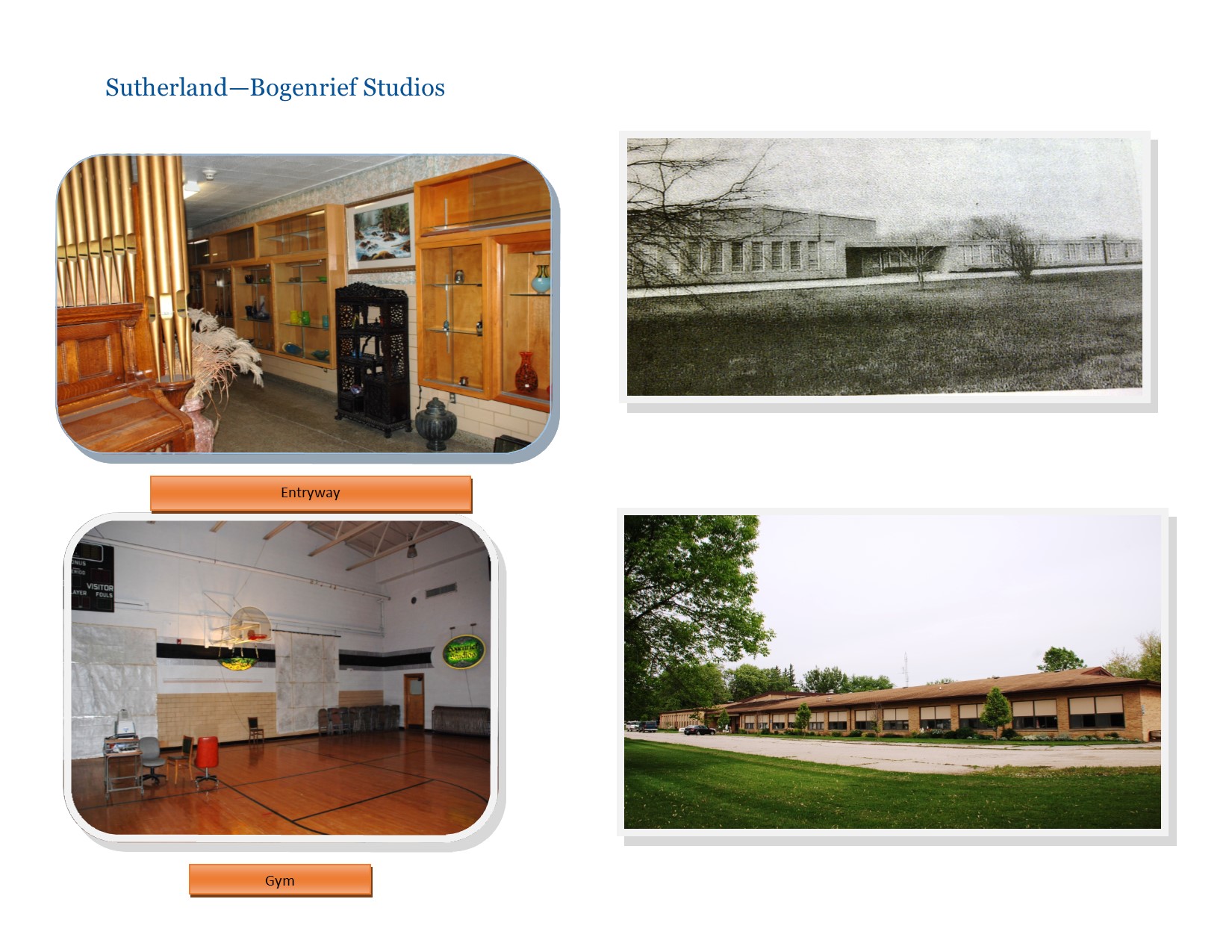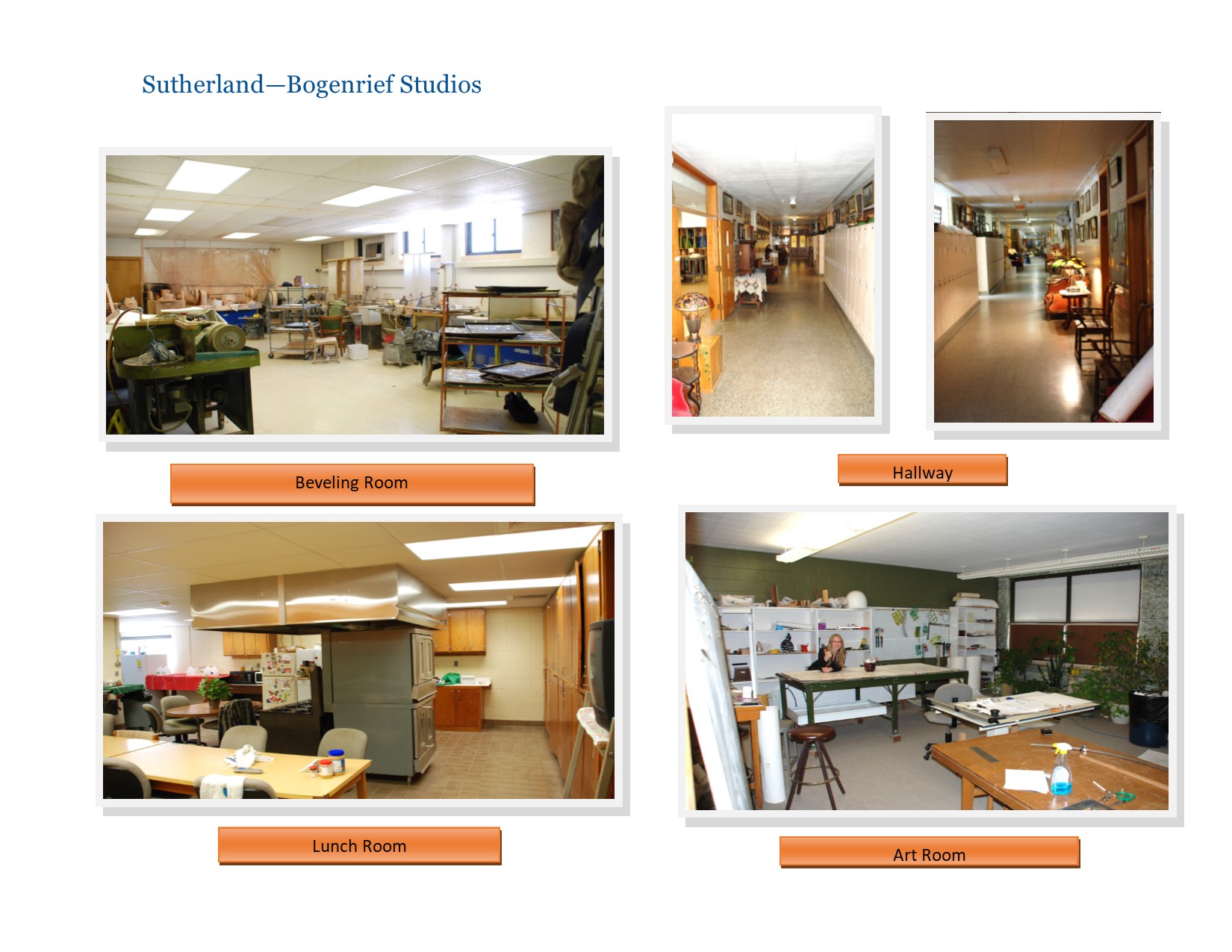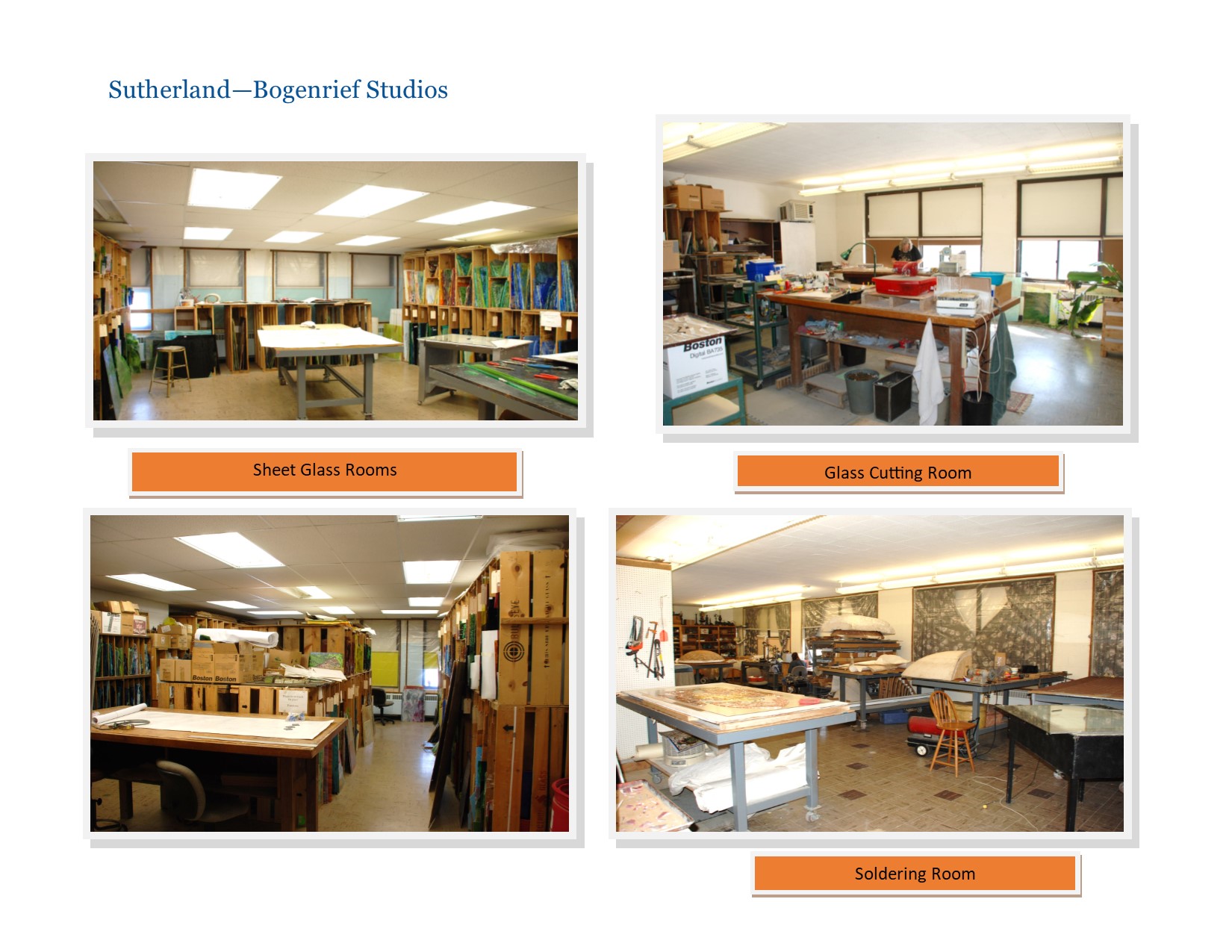Sutherland Buildings
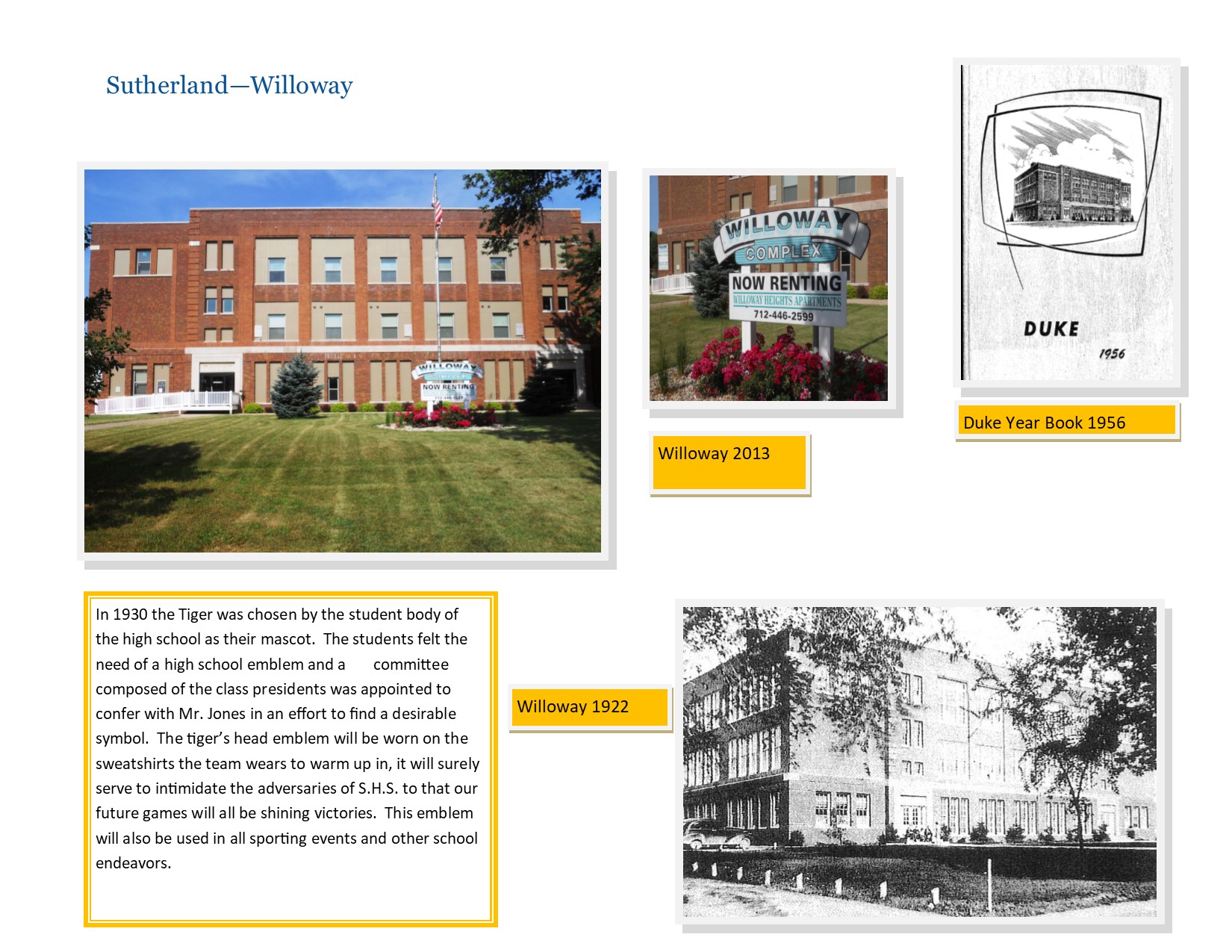
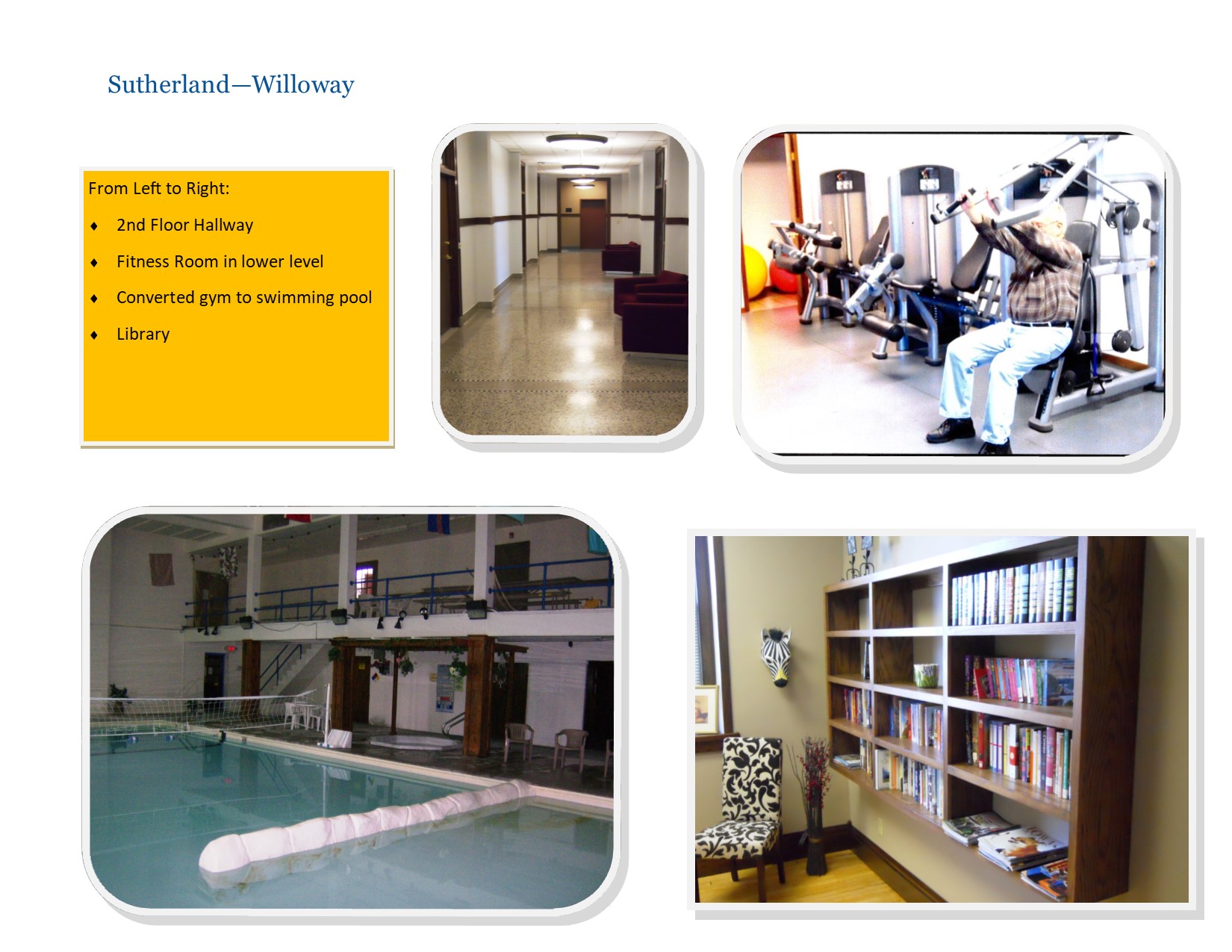
Sutherland—Willoway
409 Ash St, Sutherland, IA
The Brick School on Ash Street
From “The Duke 2008 – Sutherland Community Schools”
In 1921 it was decided by the Board of Education of the Sutherland Consolidated School District to tear down the old wood structure school building (built in 1885) and build a more fitting environment for the children to learn and study in. Work progressed for a full year—first the demolition and then digging the new hole for the gymnasium. Brick and block walls were soon going up, creating the shell of this academic fortress, to be seen by all who passed by that first summer. The new 4-story brick building was built on the same site of the old wood school building. The 1st story would be underground with the 2nd story above the gymnasium open, an innovative structure, at this time of construction history.
The new school building was enclosed with the roof and windows completed before the snow blew that first winter. Workers labored long days and many citizens from the community helped were they could. They hauled mortar, nailed boards and laths, laid plaster, laid flooring, painted, and finished the woodwork. It was a tribute to the community that such a fine building could be completed in 18-months.
On December 18, 1922 the new 4-story brick school building on Ash Street was dedicated. (This is now the Willoway Complex.) Lieutenant Governor John Hammil was the guest speaker at the dedication ceremony. The American Legion presented an enormous American flag to be hung outside the school.
The rural country schools now taught only the younger students. Four busses went out to the country to pick up the older children. School Board members at this time were A.A. Innes, F.E. Tellier, H.J. Briggs, J.E. Sweeney, and A.H. Schultz. Ed Briggs was secretary and H.N. McMaster was treasurer. The community paid the debt of $120,000.00 in just over twenty-five years.
In 1955, very high enrollment created a need for a new facility. At the October 1955 School Board meeting, the Board approved a bond issue vote totaling $363,000.00 for a new school building. It was decided that a new high school building would be built along Highway 10. The three-story structure on Ash Street that had served the district so well would become the elementary building. R.L. Kinkead was Superintendent, Victor Christensen was Principal; School Board members were V.S. Flinders as president, W.R. Steinert, Alvern Tjossem, Irvin Struve, and Myron Hill.
By the time the 1961-1962 school year arrived, enrollments had dropped in the area and school reorganization laws had changed in Iowa, allowing small schools to merge students, buildings and activities. Sutherland, Calumet and Gaza merged and became the Sutherland Community Schools. Classes for the elementary grades continued to be held in the old school on Ash Street in Sutherland.
In 1993, Sutherland Community Schools merged with Paullina and Primghar schools to form the South O’Brien School District. At this time, the three-story schoolhouse on Ash Street was closed.
“Where There’s a Will, There’s a Way”
In July, 1995 the Sutherland Recreation Corporation (which was at that time inactive) met and voted to take on the proposed project of repurposing the then vacant elementary school building beginning with Phase I - converting the gymnasium area into an indoor swimming pool. A Pool Committee was formed to spearhead fundraising efforts and within a few days, they had raised $40,000 from the business community. The next step was to acquire the building. This endeavor became controversial when Sutherland Recreation Corporation (SCS) asked the South O’Brien School District not only for the building but also a donation toward the project since they would not have to pay demolition costs. On October 24, 1995, a special school board meeting was held in the Sutherland gym with a record 100 concerned community members attending. A motion was voted on and approved to offer the City of Sutherland the lot, building and improvements up to the amount of the lowest demolition bid of $43,500. Fundraising efforts continued on through the fall and on December 18, 1995, the SRC was able to report to the Sutherland City council that all but $18,900 of the needed $175,000 for Phase I had been raised. The Sutherland City Council voted unanimously to enter into a 28E agreement with the South O’Brien School District. The property on Ash Street was then transferred to the city, who in turn handed it over to SRC for renovation.
In the summer of 1996, a name for this community project was chosen from among 40 entries in the “Naming Game”. Maureen Amendt submitted the winning entry, “Willoway”, with the concept of “where there’s a will, there’s a way” behind it. The SRC chose to name the building the Willoway Complex and by October 1st of that year, the City of Sutherland leased office space and moved into a portion of the building. At this time, the building had a new roof and brick tuck pointing had been completed. It is worth noting that the removal of the gymnasium floor and excavation for the pool was accomplished through the sole use of volunteers. Soon the pool and whirlpool had been installed and once again, volunteers turned out to pack the sand around the pool before the deck was poured and to add many of the finishing touches. The lunch room and kitchen were then divided creating an activity room, office space and kitchen. Lockers were painted and the handicap restroom/family changing room was equipped and decorated. Finally, fitness equipment was donated and installed and on November 22, 1996, the Splash Pool and Fitness Center opened for business. The Willoway Complex Grand Opening was held on December 8, 1996.
Over that winter, the finished activity center became home to the Senior Dinner Date and hosted various card groups throughout the week. The activity center and kitchen as well as the pool began to be rented out for many different types of occasions. In the spring of 1997, Willoway entered into a contract with “Green Thumb” participants and Wurth Chiropractic Clinic held its grand opening. In May of 1997, a guaranteed loan of $380,000 was received from the USDA Rural Development Program to complete remodeling on all but the top floor. In March, 1998, the fitness center expanded into a newly remodeled space on Willoway’s second floor and a $13,000 grant was received to assist with the elevator installation. In June of that same year, SRC was the recipient of a $6,000 grant to pay for the architectural design of the second and third floors. Salvaged items were auctioned off in August of ’98 to prepare for the development of Willoway Heights. That fall, the Foundation Academy, a private school, opened at Willoway Complex and occupied the second floor until the spring of 2000 when they outgrew the space.
In January of 1999, the Willoway Heights project received a boost in the form of a $200,000 LHAP grant to help finish eight senior luxury apartments on the third floor. After construction, volunteers once again turned out to clean and ready the apartments. They even staged an apartment for the open house, held on April 1 & 2 of 2000, with furniture on loan from Moeller Furniture. In October of 2000, garages and car ports were added for use by the residents of Willoway Heights.
The story of the Willoway Complex is truly an inspiring one of a small rural community coming together, sharing their talents and persevering over many years to see a common dream come true. From volunteers to grant writers to those who supported the fundraising, all have been key components in making the dream a reality. Willoway, a building that once educated the community’s youth, has been repurposed into a building that contributes to the community year round and truly shows “Where There’s a Will, There’s a Way.”
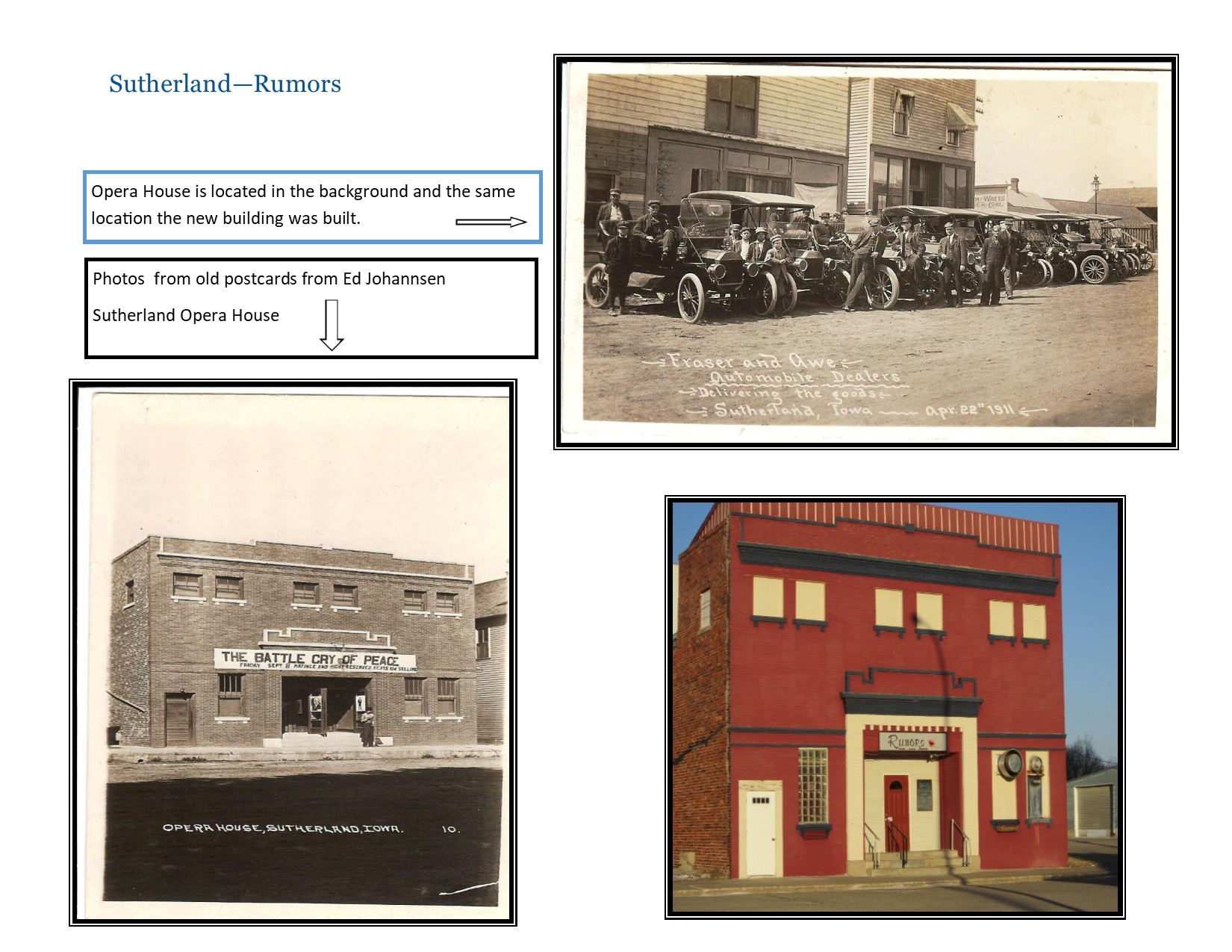
Sutherland— Rumors
107 Main St., Sutherland, IA
1897—Opera House
“Commencement exercises of the Sutherland Schools were held at the Opera House last Friday. Miss Sylvia Steele, the only graduate this year, gave an oration on ‘Education’. W.H. Bloom talked to the audience for a few minutes on the practical value of a higher education and presented on behalf of the school board the diploma Miss Steele had earned.” June 25, 1897 Sutherland Courier.
“Next Tuesday at the Opera House will be a lecture everyone should hear. “The Bright and Dark Side of Life in Andersonville and other Southern Prisons’. The lecturer is John W. January and he speaks from Personal Experience. Captured and taken to Andersonville and later to Florence. At the latter place his feet became affected with gangrene. The hospital surgeon refused to cut the feet off, saying the prisoner would not live anyway. January borrowed an old jack knife and cut off his feet at the ankles and lived. He was finally exchanged and in time recovered, and now, with artificial feet walks very well. The lecture goes to benefit the library fund. Admission 25 cents and 15 cents. “John January talked 2 ½ hours and kept people breathless.” December 1897 news, Sutherland Courier.
1912
“It is reported by good authority that a private electric light plant will, in the near future, be installed in the opera house. This will be used in connection with the moving picture machine and also to light the house and stage.” Sutherland Courier, 1912
Carl Johannsen, Otto Behmer, Elmer Sieh, and Ernest Claussen often played for dances at the Opera House. Sutherland Bicentennial Book, 1976.
1914—1st Opera House is moved and a new Opera House is built
The old Opera House was moved in 1914 from the street, Asa Bailey bought a part of it for a double corn crib and Mr. Knott used the rest for an addition to his implement building. Sutherland Bicentennial Book, 1976.
Sutherland opened their new Opera House. Sutherland Quasi Book, 2008
1915
The opera House was showing the J. Stuart Blackton film “The Battle Cry of Peace” a 1915 war epic propaganda film. The movie theme is enemies of the United States are using pacifists as pawns to insure that the United States Government does not spend too much money on defense. So when the enemies, who look like German soldiers, invade the United States the United States would be unable to defend itself. Leading actors were Charles Kent, Harold Huber, Paul Scardon, Julia Swayne Gordon, Louise Beaudet, and Norma Talmadge. Sutherland Quasi Book, 2008.
Hilda Behmer played the piano and accompanied the silent movies at the theatre. If the horses were running she was in time to them, if it was sad, so was her playing. Sutherland Bicentennial Book, 1976.
1929—Opera House becomes a Theatre
First Talkies Heard and Shown in Theatre Last Friday Night:
“For the first time talkies were heard and pictures shown in the theater here last Friday night, followed by similar shows on the next three evenings. Their installation by Mr. and Mrs. Chas L. Nott marked a distinct advance step in the motion picture business and placed Sutherland far ahead of most neighboring towns in the matter of cinema entertainment. Many towns and cities much larger than this, do not have this kind of pictures and probably many of them never will have.
Packed housed greeted theses first pictures. The auditory effects obtained add a great deal to the optical version and will without doubt transform the whole business. To properly control the talkie, we understand, much more is involved than the mere production of sound waves. The rebound or echo, is a factor of importance and is variable according to the number of persons in the theater. When a building is full the echo has no effect, but when only partly filled it becomes more active and requires some sort of harnessing.
The movies are tackling a big problem and an expensive one; operators also have new conditions to meet, but like all other advances will accomplish perfection. Movie stars, also are likely to have their troubles with the talkie, because a face with a voice will prove a serious handicap and probably eliminate some of those now burning so brightly in the movie firmament” April 5, 1929 Sutherland Courier
Another story in a May edition said that the first talking pictures show was “The Shopworn Angel” starring 27 year old Gary Cooper and 26 year old Nancy Carroll. It was a romance set during World War I. Sutherland Quasi Book, 2008.
1954
Everett Olhausen announces that he has purchased the Sutherland Theatre from Don Henry. Everett plans to install an up-to-date widescreen.” April 29, 1954 Sutherland Courier.
1964
The Articles of Incorporation of the Sutherland Recreation Corporation were adopted June 22, 1964. The Corporation’s purpose is to encourage, promote and assist the development of educational, recreational and cultural facilities for the residents of the town and rural area, especially to develop such facilities for the benefit of the youth of the community. Sutherland Bicentennial Book, 1976.
The Board consists of eight Directors. The first ones were: Martin C. Krekow as president, Keith Jennings as vice president, Henrietta Saienga as secretary-treasurer, Bernard Kas, Edward Horstmann, Robert Syndergaard, Virgil Bendlin, and Oscar Adams. The directors are elected to a term of two years with four being replaced every year. Sutherland Bicentennial Book, 1976.
1965
The first annual meeting was held February 10, 1965. All directors were re-elected for another term. The By-Laws of the Corporation were accepted at this meeting. Sutherland Bicentennial Book, 1976.
1968—A youth center opens in the basement of the theatre
Youth Center (basement of Sutherland Theatre) opened on April 29, 1968, with a dance. The music was furnished by The Scavangers. Dances were held in the Center on Saturday nights after the movie. In December of 1968 the Center was closed due to the lack of participation of the youth. Sutherland Bicentennial Book, 1976.
1975—Senior Citizen Center rents the Theatre basement
In February of 1975 at the annual meeting the Sr. Citizens asked to rent the basement. Since that time it is known as the Senior Citizen Cener. Sutherland Bicentennial Book, 1976.
1976
“A new screen improves the picture at the Sutherland Theatre.” February 26, 1976 Sutherland Courier.
The Sutherland Recreation Corporation has been Incorporated for 12 years. This has been done through the efforts of several people who have volunteered their time to keep the theater running.
The present Board of Directors are: Dick Freeman as president, Bernard Peterson as vice president, Zelma Sholly as secretary-treasurer, Doug Rohwer, Brian Engelke, Tom Sweir, Charles Kummerfeld, and Clyde Klave. Much credit should be given to the wives of the members for their volunteered time, also. It is the hope that with volunteer help, and participation from the people in Sutherland and surrounding areas, the Corporation will keep going for many years. Sutherland Quasi Book, 2008
1986
“Center Attractions is a community project which was started about a year ago. The project included restoring the old Sutherland Theatre building and returning it into a place for the youth of the community.” June 26, 1986 Sutherland Courier Center Attractions Multi-Purpose Youth Center, held it Grand Opening on June 27,28, & 29. Balloons were released with a card attached to each one that read, “Every card returned to Center Attractions will receive a free gift.” There were six returned cards. Kortlan Castleberry, age 3, Nashville, Arkansas on July 7, 1986. One was retrieved from a pond at Bradgate, IA on June 28, 1986, these people said they had found two others plus one from Hartley, IA. Another was a commercial fisherman near Batchtown, Illinois. Another at the Truman Davis Farm - 22 miles east of Mt. View, Arkansas on July 5, 1986. Carolyn Thacker of Mt. Pleasant said her son found one in the middle of his bean field on July 8, 1986. The final one stated he also found his in his bean field while cultivating, he lived on the north side of Lake Darling near Brighton, Iowa. Sutherland Quasi Book, 2008.
1994—Sutherland Theatre becomes a Bar/Grill called Huck’s Place
Sutherland Theatre was transformed to a Bar/Grill establishment. Recorded owners: Bubba & Jodi Munn, Les & Lisa Huckabee, Richard & Becky Bedsaul, Liz Peters, and presently owned by several investors .
2004—Huck’s Place is now Beddy’s Bar & Grille
“The building that once housed Huck’s Place stood dark for several months when the Huckaby’s decided to close their business and put their property up for sale. This opened the door of opportunity for Richard and Becky Bedsaul of Sutherland to fulfill a dream of being self-employed. The whole family has been busy cleaning and remodeling for the Grand Opening of Beddy’s Bar and Grille. June 24, 2004 Sutherland Courier.
Currently it is home to Rumors Bar & Grille
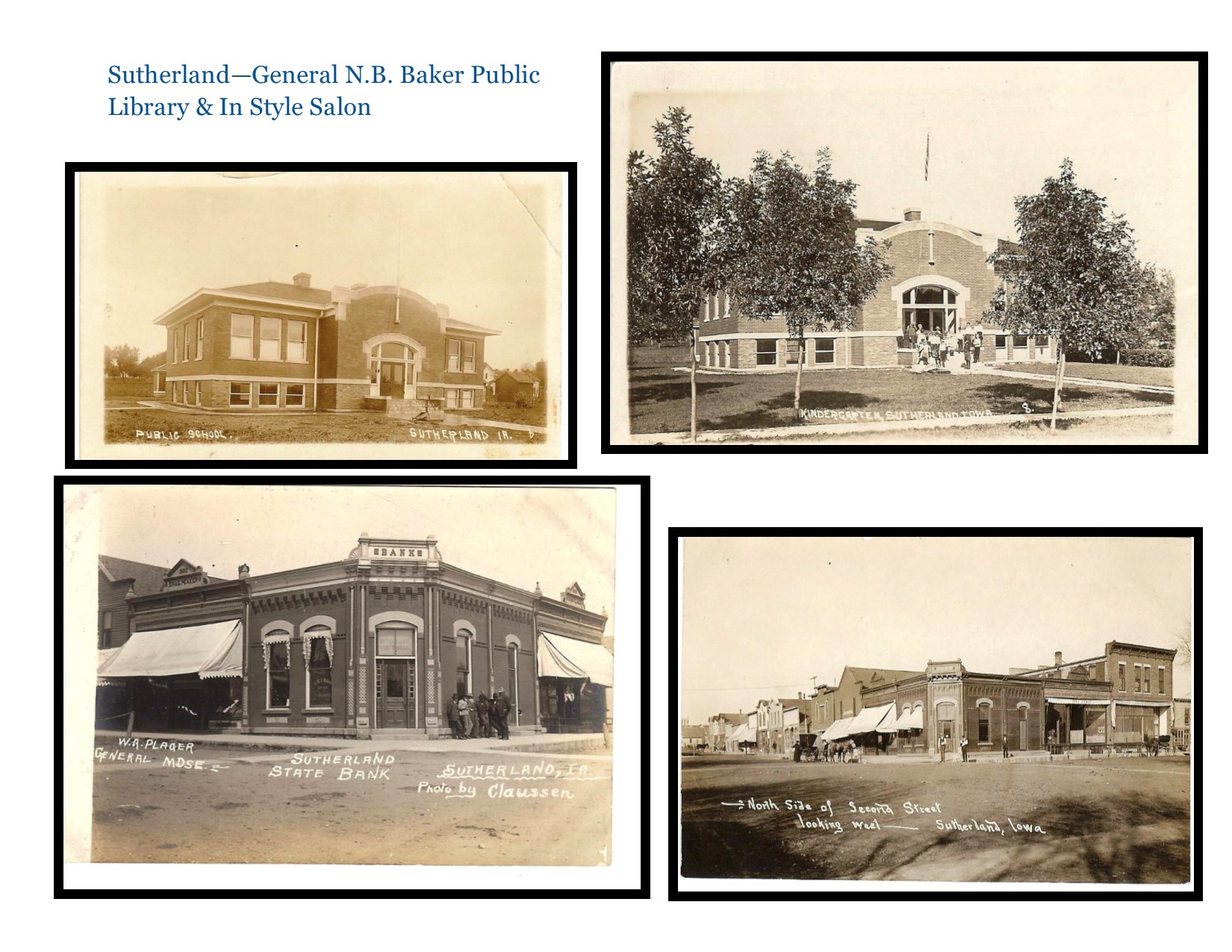
Sutherland—General N.B. Baker
315 Ash Street
Sutherland--In Style Salon
119 Main Street
Photos from old postcards from Ed Johannsen:
The former Public School building is now the General N.B. Baker Public Library. What once was the Sutherland State Bank now houses In Style Salon.
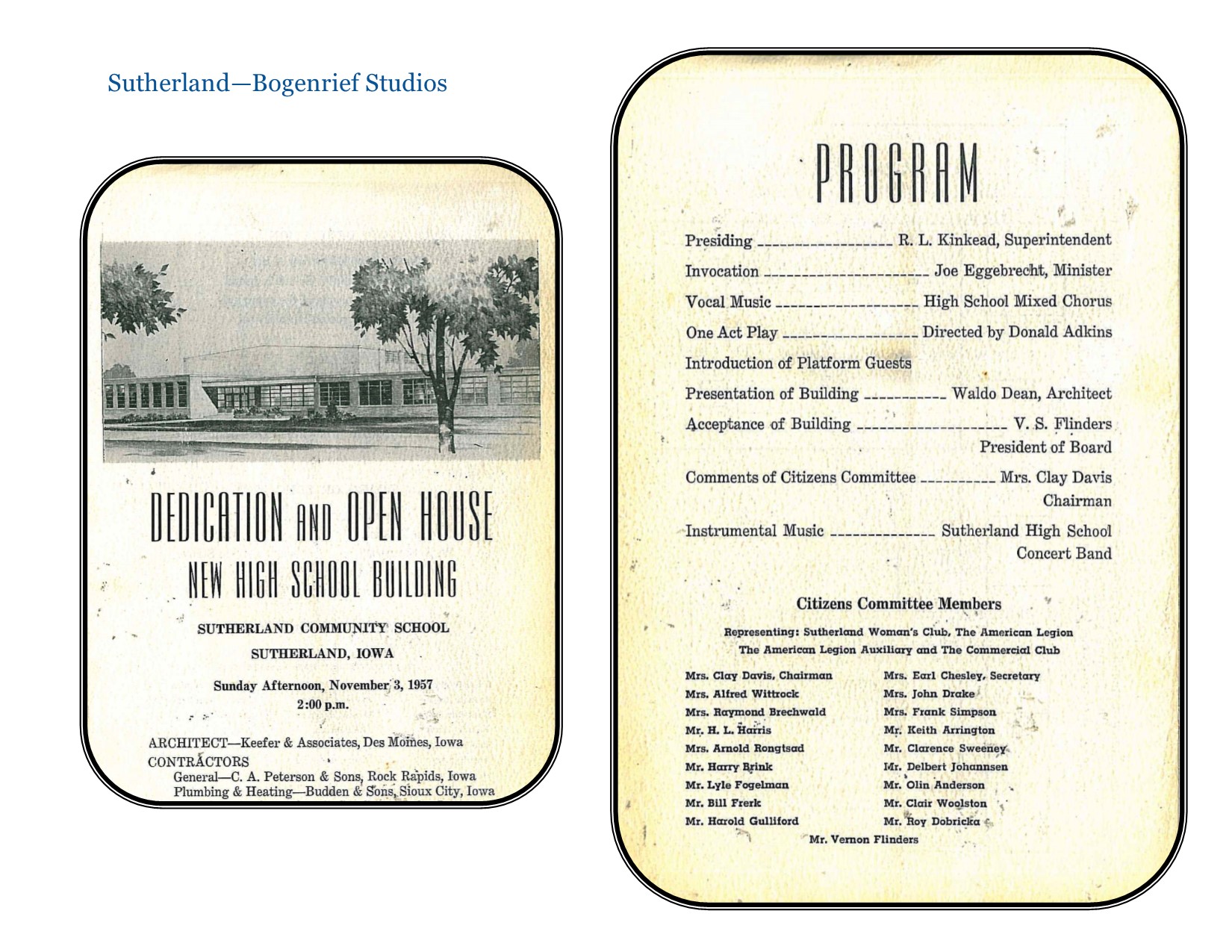
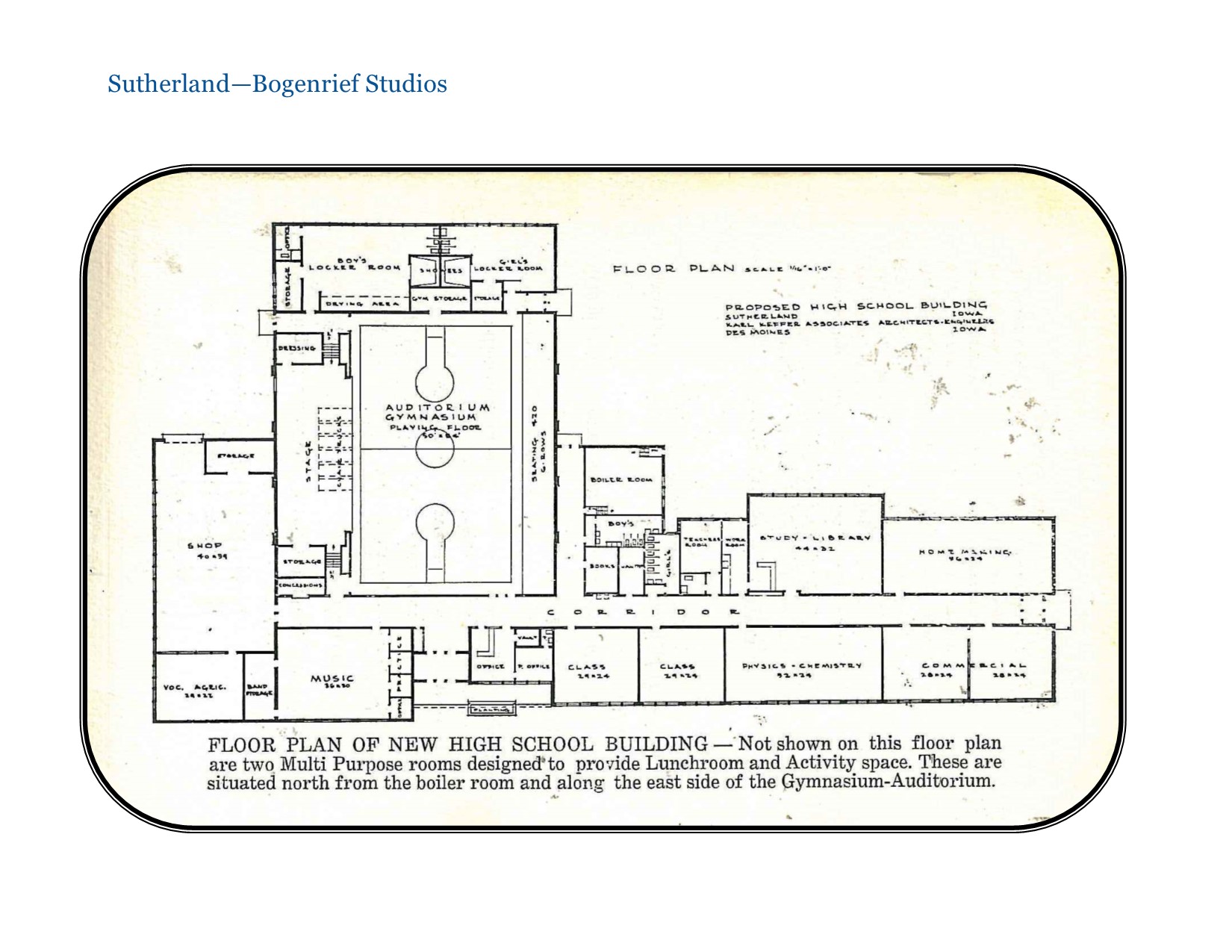
Sutherland—Bogenrief Studios
220 W Southern St, Sutherland, IA
Bogenrief Studios
Enrollment was very high in Sutherland and the need for a new modern facility to handle the overflowing classrooms was desired.
At the October 1955 School Board meeting the Board approved a bond issue vote totaling #363,000.00 for a new school building. The bond issue was approved 489 to 220 in the November 1955 vote. An unprecedented 69% approval.
Discussion then followed as to where the school would be built, the best design for the structure and which classes would use the new building.
It was decided; a new high school building was built along Highway 10. The three-story structure on Ash Street that has served the district so well will now be the elementary building. R.L. Kinkead was Superintendent, Victor Christensen was Principal; School Board members were V.S. Flinders as Prisiden, W.R. Steinert, Alvern Tjossem, Irvin Struve, and Myron Hill.
The Duke 2008
Currently the school is home to Mark and Jeanne Bogenrief and Bogenrief Studios.
